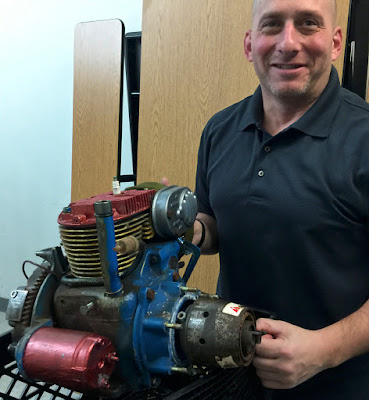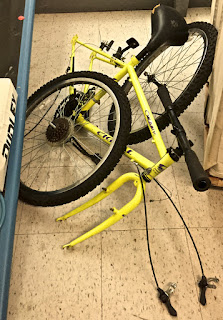At the School of Information Technogy in Paterson, NJ, Chemistry Teacher Sweet, and Art Teacher Simon, have collaborated on joint STEAM project that used art
and research to create a large collaborative bulletin board.
In this project, Ms. Sweet's chemistry students each first researched one element from the Perioidic Table of Elements. STEAM Art Professor in Residence, Triada Samaras interviewed them to understand how the project was created.
The high school chemistry students explained to her:
"We did research and found background information on our elements before we made the artwork. So we learned all about the element we were assigned. We also learned how each element helps in our everyday lives. Then we could understand how to best create artwork that represented our elements. Ms. Simon then helped us with the artwork. It was much more fun than getting to only write about the elements."

 For example one student researched the element
For example one student researched the element
hafnium and discovered, "it's used in dentistry, cars, jewelry-making and white gold!" Another student researched "titanium which is used to make airplanes, power plant tools, and pipes." Another student chimed in, "Hafnium is also used for fire rockets and the flashlights on cameras."


Currently Ms. Reyes and her STEAM art students are studying another ancient clay form: tribal African masks. These masks were used from the earliest days of civilization. She explains, to her students, "The fascinating chemistry of pottery assures that these masks have been incredibly well preserved over time."

In the meantime, across the hall, School of Government Art Teacher Mr. Jones has also been working in clay with his students. These STEAM art students are learning how the heat of their kiln can bisgue fire the clay to change its physical state. In addition, they are gaining an understanding of how the heat of the kiln makes their glazed pot colors permanent.
All in all, students at the three high schools are getting many opportunities to learn how many intersections exist between chemistry and art thanks to the Geraldine R. Dodge STEAM grant!
In this project, Ms. Sweet's chemistry students each first researched one element from the Perioidic Table of Elements. STEAM Art Professor in Residence, Triada Samaras interviewed them to understand how the project was created.
The high school chemistry students explained to her:
"We did research and found background information on our elements before we made the artwork. So we learned all about the element we were assigned. We also learned how each element helps in our everyday lives. Then we could understand how to best create artwork that represented our elements. Ms. Simon then helped us with the artwork. It was much more fun than getting to only write about the elements."

 For example one student researched the element
For example one student researched the elementhafnium and discovered, "it's used in dentistry, cars, jewelry-making and white gold!" Another student researched "titanium which is used to make airplanes, power plant tools, and pipes." Another student chimed in, "Hafnium is also used for fire rockets and the flashlights on cameras."
In the meantime School of Culinary Arts, Hospitality, and Tourism art teacher Vivian Reyes has been combining chemistry and art in another fascinating STEAM Art project: a clay/pottery study. In her classroom, STEAM art students studied "The Chemistry of Pottery" to learn many fascinating scientific facts about pottery before they began working with the clay. For example, "The process of firing a pot creates cross links between the hydroxyl groups in the clay. Oxides of the first row transition metals are the main sources of color in pottery glaze" LINK Next
Ms. Reyes taught students how to make clay vessels using coils, a
project that requires math and measurement as well as engineering. Hand building a pot is the earliest method of making a pot and is thousands of years old.

In the meantime, across the hall, School of Government Art Teacher Mr. Jones has also been working in clay with his students. These STEAM art students are learning how the heat of their kiln can bisgue fire the clay to change its physical state. In addition, they are gaining an understanding of how the heat of the kiln makes their glazed pot colors permanent.
All in all, students at the three high schools are getting many opportunities to learn how many intersections exist between chemistry and art thanks to the Geraldine R. Dodge STEAM grant!































